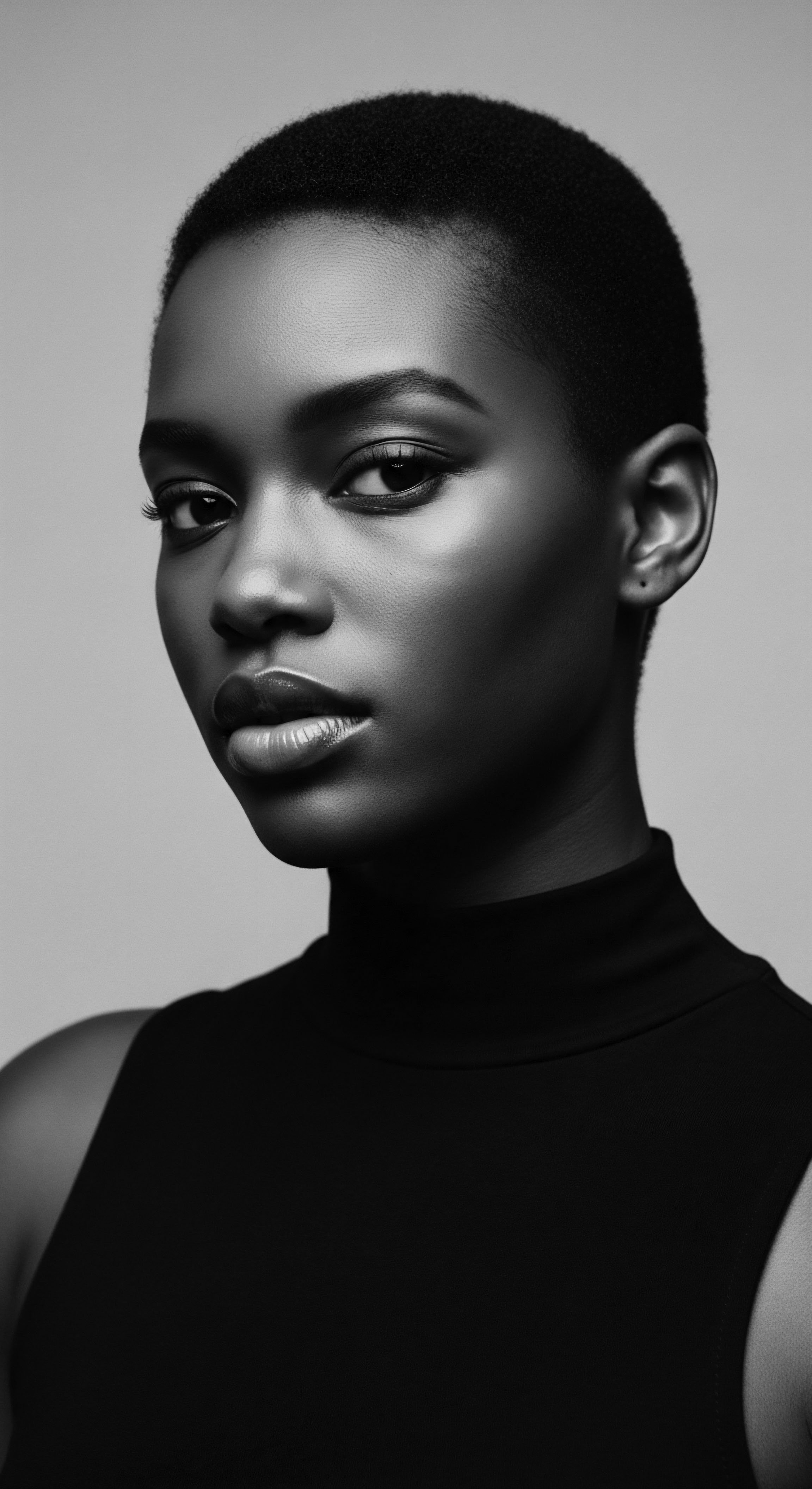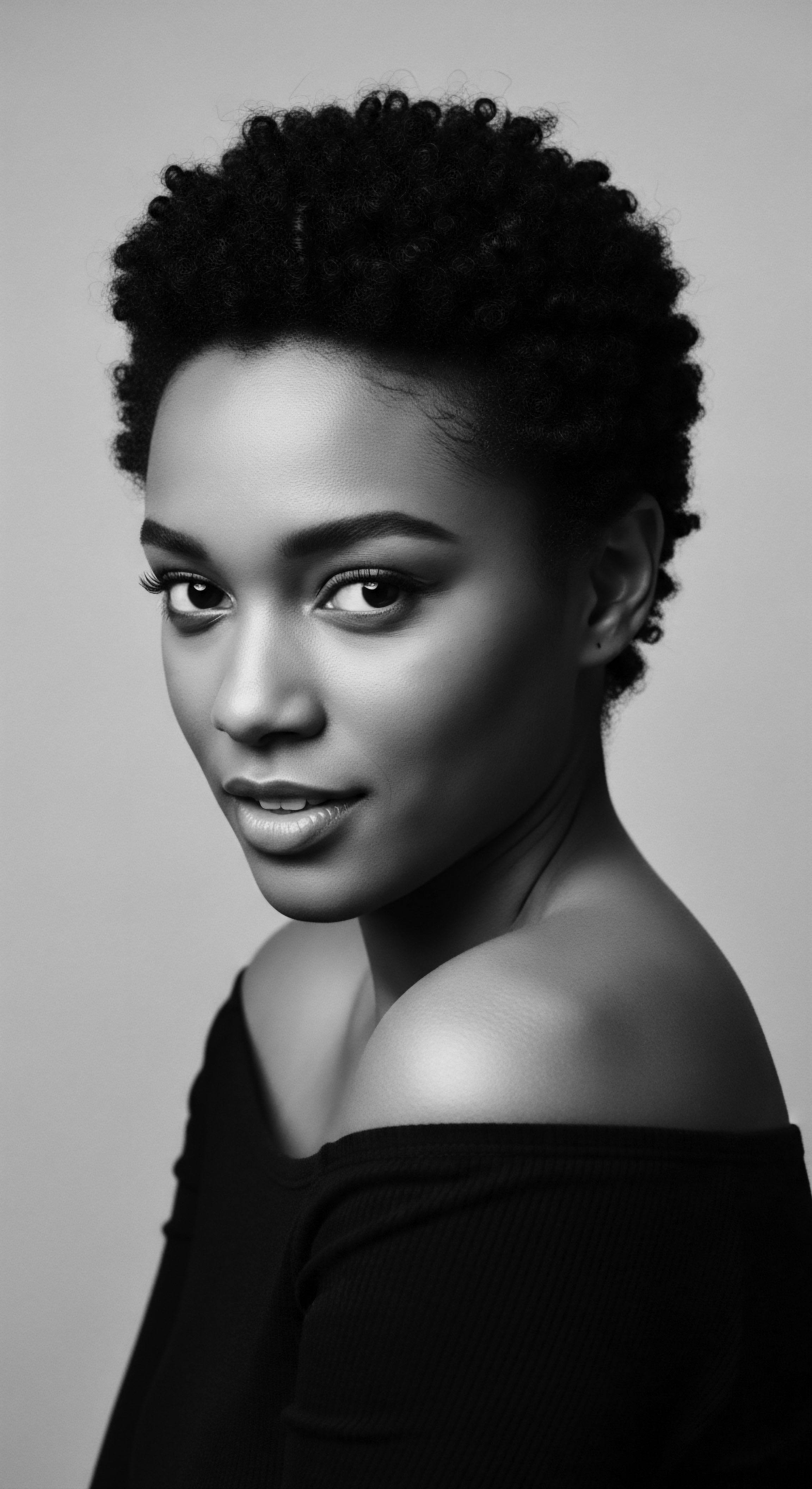
Fundamentals
The concept of Systemic Bias, when viewed through the lens of textured hair heritage, reveals a pervasive and often unseen influence on how we perceive, value, and interact with hair that springs from ancestral African roots. At its core, Systemic Bias refers to the inherent inclinations or prejudices embedded within societal structures, institutions, and cultural norms that consistently privilege certain groups while disadvantaging others. This is not about individual acts of malice, but rather the cumulative effect of established practices, policies, and widespread beliefs that, over time, create inequitable outcomes. For those with Black and mixed-race hair, this translates into a world where Eurocentric beauty standards often reign supreme, subtly or overtly diminishing the innate beauty and versatility of coils, kinks, and waves.
Consider the foundational meaning of “Systemic Bias” as a deeply ingrained pattern of favoring one type over another, a pattern woven into the very fabric of our shared understandings. This extends far beyond personal preferences, reaching into the very systems that govern daily life. In the realm of hair, it manifests as the unstated assumption that straight, smooth hair is the norm, the default, the “good” hair, while textured hair is often labeled as “unruly,” “unprofessional,” or “difficult.” This designation, often unspoken, becomes a part of school dress codes, workplace policies, media portrayals, and even the availability of hair care products.
Echoes from the source reveal that in pre-colonial African societies, hair was a profound marker of identity, status, and spiritual connection. Hairstyles conveyed marital status, age, tribal affiliation, wealth, and even religious devotion. Intricate braiding patterns and elaborate adornments were not merely aesthetic choices; they were living narratives, a visual language understood within communities.
The communal act of hair grooming was a cherished ritual, strengthening familial bonds and transmitting ancestral wisdom from one generation to the next. This rich cultural heritage, where hair was revered and celebrated in its natural forms, stands in stark contrast to the devaluation that arrived with colonial encounters and the transatlantic slave trade.
Systemic Bias in hair culture represents an enduring pattern of favoring Eurocentric beauty ideals, subtly or overtly diminishing the inherent beauty of textured hair and its ancestral narratives.
The very idea of “good hair” and “bad hair” became a deeply painful and damaging component of this bias, directly linked to the legacy of slavery. Enslaved Africans had their heads forcibly shaved as an act of dehumanization, a deliberate erasure of their cultural identity and ancestral connections. This act stripped away a vital part of self-expression and community.
Over generations, the pressure to conform to European aesthetics led to the widespread adoption of straightening practices, often involving harsh chemicals or heated tools, in a quest for acceptance and survival within a biased society. This historical trajectory highlights how a preference, initially rooted in power dynamics, became institutionalized, shaping perceptions and practices for centuries.
The subtle yet powerful nature of this bias means it often operates beneath conscious awareness. A child, observing media or school environments, might internalize the message that their natural coils are somehow less desirable, even without explicit instruction. This early socialization can lead to a self-perception where one’s natural hair is seen as a problem to be solved rather than a crown to be honored. The journey of understanding Systemic Bias in this context begins with recognizing these deeply embedded historical and cultural forces that have shaped our collective understanding of beauty and professionalism, particularly as it relates to hair.
To truly grasp the foundational meaning of Systemic Bias, we must look to the ways in which historical oppression became codified into everyday life. The forced alteration of hair, whether through literal shaving during enslavement or the later societal pressure to chemically straighten, was not simply about appearance; it was about control and the imposition of a dominant cultural aesthetic. This historical reality provides a crucial lens through which to comprehend the enduring impact of Systemic Bias on textured hair heritage today.

Intermediate
Moving beyond the foundational understanding, the intermediate exploration of Systemic Bias reveals its complex operation within various societal structures, particularly as it impacts Black and mixed-race hair experiences. This deeper meaning encompasses the subtle yet potent ways that institutional norms, media representation, and commercial industries perpetuate a singular vision of beauty, often at the expense of textured hair. It becomes evident that the bias is not merely a collection of individual prejudices, but a deeply interwoven system of disadvantage.

The Silent Policing of Appearance
The silent policing of appearance, particularly concerning hair, is a potent manifestation of Systemic Bias. This occurs when unwritten rules about “professionalism” or “neatness” disproportionately penalize natural Black hairstyles. In workplaces and educational settings, individuals with coils, locs, or braids have historically faced disciplinary actions, limited opportunities, or even job offer rescissions because their hair was deemed “unacceptable” or “messy”.
This often compels individuals to alter their natural hair, a significant aspect of their identity, simply to assimilate into spaces that enforce these unjust norms. The meaning of Systemic Bias here becomes clear ❉ it is a force that pressures conformity to a narrow aesthetic, effectively marginalizing those whose natural presentation falls outside the dominant standard.
Consider the historical context of the Tignon Laws in 18th-century New Orleans. These laws mandated that free Creole women of color cover their elaborate, natural hairstyles with a tignon (a headscarf). The stated purpose was to distinguish them from white women and signify their lower social standing, regardless of their freedom. This historical example powerfully illustrates how systemic bias, enforced through legislation, aimed to suppress cultural expression and reinforce racial hierarchies.
Despite these laws, women of color transformed the tignon into an art form, using vibrant fabrics and creative wraps, demonstrating a profound resilience and an ongoing dialogue with oppression. This act of defiance, a quiet yet potent reclamation of identity, speaks volumes about the enduring spirit of textured hair heritage.
Systemic Bias often operates through unwritten rules of ‘professionalism’ that disproportionately penalize natural Black hairstyles, forcing a choice between authentic self-expression and societal acceptance.

Commercial Landscapes and Cultural Erasure
The commercial landscape also mirrors and reinforces Systemic Bias. For decades, the mainstream hair care industry largely overlooked the unique needs of textured hair, prioritizing products designed for straight or wavy hair. This lack of appropriate products often led to the use of harsh chemical relaxers, which could cause significant damage to the scalp and hair, in pursuit of the straightened aesthetic. The underlying meaning of this bias is an economic one, where market demand for products catering to textured hair was either ignored or actively suppressed, reflecting a broader societal devaluation.
Moreover, the language used in marketing and media often contributed to the negative perception of textured hair. Terms like “frizzy,” “unmanageable,” or “nappy” became common descriptors, internalizing a sense of inadequacy within communities. This subtle form of bias, though not overtly discriminatory, shapes consumer choices and self-perception, reinforcing the idea that textured hair requires “taming” rather than nurturing. The proliferation of products designed to alter, rather than celebrate, natural texture stands as a testament to this deep-seated commercial bias.
- Eurocentric Beauty Standards ❉ The pervasive idealization of straight, smooth hair as the benchmark for beauty, influencing media, product development, and societal acceptance.
- Hair Discrimination ❉ The differential treatment, microaggressions, or outright bans based on hair texture or style, particularly affecting individuals with Afro-textured hair in schools and workplaces.
- Internalized Self-Hatred ❉ The psychological toll on individuals who absorb negative societal messages about their natural hair, leading to attempts to conform to dominant beauty norms.
- Cultural Appropriation ❉ The adoption or imitation of Black hairstyles by those outside the culture, often without understanding or respecting their historical and cultural significance, while the originators still face discrimination for wearing them.
The persistent influence of Systemic Bias means that even as progress is made, its roots run deep. The emergence of the natural hair movement, a powerful reclamation of ancestral beauty, stands as a testament to the resilience of Black and mixed-race communities in challenging these long-held biases. This movement, however, still navigates a world where the systemic preference for certain hair types continues to exert its influence, underscoring the ongoing need for awareness and change.
| Historical Period Pre-Colonial Africa |
| Dominant Societal Perception of Textured Hair Symbol of identity, status, spirituality, and community. |
| Impact on Hair Practices and Identity Diverse, intricate styles; communal grooming rituals; hair as a living narrative. |
| Historical Period Slavery/Colonial Era |
| Dominant Societal Perception of Textured Hair Dehumanized, "unruly," "animalistic"; associated with inferiority. |
| Impact on Hair Practices and Identity Forced shaving; pressure to straighten for survival/assimilation; Tignon Laws. |
| Historical Period Post-Emancipation/Early 20th Century |
| Dominant Societal Perception of Textured Hair "Bad hair" vs. "good hair" dichotomy; associated with lack of professionalism. |
| Impact on Hair Practices and Identity Rise of hot combs and chemical relaxers for conformity; Madam C.J. Walker's innovations for Black hair care. |
| Historical Period Civil Rights Era (1960s-1970s) |
| Dominant Societal Perception of Textured Hair Symbol of Black pride, resistance, and political statement. |
| Impact on Hair Practices and Identity The Afro becomes a powerful symbol of self-acceptance; challenges to Eurocentric beauty standards. |
| Historical Period Contemporary Era (Natural Hair Movement) |
| Dominant Societal Perception of Textured Hair Growing acceptance, but still faces systemic discrimination in professional/academic settings. |
| Impact on Hair Practices and Identity Reclamation of natural textures; advocacy for anti-discrimination laws (CROWN Act); ongoing mental health impacts from bias. |
| Historical Period The journey of textured hair reveals a continuous interplay between oppression and resilience, a testament to the enduring spirit of cultural heritage. |

Academic
From an academic vantage, Systemic Bias represents a complex, multi-layered phenomenon, not merely a collection of individual prejudices, but a deeply embedded and self-perpetuating arrangement of social, cultural, and economic structures that consistently disadvantage specific groups. Its meaning transcends simple discrimination, denoting the pervasive and often invisible mechanisms that reproduce inequity. Within the context of textured hair heritage, Systemic Bias delineates the historical and ongoing marginalization of Black and mixed-race hair forms through the imposition of Eurocentric aesthetic norms, influencing everything from legal frameworks to psychological well-being. This delineation necessitates a rigorous examination of power dynamics, historical legacies, and their profound impact on identity.

Deconstructing the Architecture of Bias
The architecture of Systemic Bias is constructed from various elements, including historical precedent, institutional policies, media representation, and the subtle yet powerful force of implicit association. Historically, the transatlantic slave trade severed ancestral connections, not least through the deliberate act of shaving the heads of enslaved Africans, erasing a vital marker of identity and status that was deeply revered in pre-colonial societies. This initial act of cultural violence established a foundation upon which subsequent biases were built. The forced assimilation that followed encouraged the adoption of European beauty standards, leading to the development of damaging hair straightening practices and products, which, as Ayana Byrd and Lori Tharps chronicle in their seminal work, Hair Story ❉ Untangling the Roots of Black Hair in America (2001), became deeply intertwined with notions of social mobility and acceptance within a dominant white society.
Academic inquiry reveals that the psychological ramifications of Systemic Bias are profound. Research indicates that Black women, in particular, face significant societal pressure to alter their natural hair, with a study by TestGorilla finding that Black Women’s Hair is 2.5 Times More Likely to Be Perceived as Unprofessional. This statistic underscores a pervasive implicit bias within professional settings, where textured hair, in its natural state, is often unconsciously associated with a lack of decorum or capability. Such perceptions compel many Black women to chemically straighten their hair for job interviews, with 54% reporting feeling this necessity for success.
This illustrates how systemic pressures can lead to choices that are detrimental to hair health and can contribute to internalized racism and negative self-image. The consequence is a deeply rooted struggle with self-acceptance, where the innate beauty of one’s heritage is constantly measured against an unattainable, externally imposed ideal.
Systemic Bias against textured hair is a deeply embedded societal architecture, influencing everything from historical subjugation to contemporary perceptions of professionalism and self-worth.
The legal and policy dimensions of Systemic Bias are particularly salient. For instance, the Tignon Laws of 1786 in Louisiana stand as a stark historical example of explicit systemic bias. These laws compelled free women of color to cover their hair with a tignon to distinguish them from white women, a direct legislative effort to enforce racial and social stratification. While these specific laws are long abolished, their legacy persists in modern-day hair discrimination cases.
The 2016 federal court case of EEOC v. Catastrophe Management Solutions, involving Chastity Jones, who had a job offer rescinded because she refused to cut her locs, exemplifies the ongoing judicial struggle to recognize hair discrimination as a form of racial discrimination. Although the Equal Employment Opportunity Commission (EEOC) argued that discrimination against locs constituted racial discrimination, the 11th Circuit Court of Appeals upheld the district court’s ruling against Jones, demonstrating the historical limitations in legal interpretations of racial identity and appearance. This case, while a setback, propelled the conversation around the need for explicit protections for natural hair.
The subsequent legislative efforts, such as the CROWN Act (Creating a Respectful and Open World for Natural Hair), represent a contemporary response to this systemic issue. California was the first state to pass the CROWN Act in 2019, explicitly prohibiting discrimination based on hair texture and protective styles in workplaces and schools. As of June 2023, twenty-three states have enacted similar legislation, yet a federal equivalent remains unpassed, underscoring the fragmented and ongoing battle against systemic hair bias. These legislative movements are a direct acknowledgment of the historical and persistent nature of hair-based discrimination, recognizing that hair is inextricably tied to racial identity and cultural heritage.

Interconnected Incidences and Long-Term Consequences
The interconnected incidences of Systemic Bias extend into the very fabric of daily life, impacting mental health, economic opportunities, and even access to education. The constant negotiation of one’s appearance to conform to Eurocentric standards creates chronic stress, anxiety, and a diminished sense of belonging for Black individuals in academic and professional spaces. The mental health consequences of hair-based stigma include internalized racism, negative self-image, and cultural disconnection. This continuous psychological burden, often invisible to those outside the affected communities, represents a significant long-term consequence of Systemic Bias.
Moreover, the economic disparities arising from hair discrimination are tangible. Limited job opportunities, slower career advancement, and lower-paid positions can contribute to existing socioeconomic inequalities. This cycle reinforces the notion that one’s natural hair is an impediment to success, thereby perpetuating the very bias it seeks to overcome. The essence of Systemic Bias, from an academic standpoint, lies in its capacity to transform arbitrary aesthetic preferences into concrete disadvantages, creating a self-reinforcing loop of inequity that impacts generations.
Understanding the academic meaning of Systemic Bias requires acknowledging its historical roots, its manifestations in institutional practices, its psychological impacts, and the ongoing efforts to dismantle it. It is a concept that demands a critical perspective on how societal norms, often invisibly, shape individual experiences and collective destinies, particularly for those whose heritage has been historically marginalized.

Reflection on the Heritage of Systemic Bias
The journey through the intricate landscape of Systemic Bias, particularly as it has touched the very strands of textured hair heritage, is more than an academic exercise; it is a profound meditation on resilience, identity, and the enduring spirit of ancestral wisdom. Roothea’s ‘living library’ acknowledges that hair is not merely a biological extension; it is a profound archive, carrying the echoes of joy, struggle, innovation, and defiance across generations. The meaning of Systemic Bias, in this light, transforms from a sterile concept into a living narrative of oppression, and crucially, of unwavering spirit.
From the earliest whispers of African communities, where hair served as a celestial map and a social scroll, connecting individuals to their lineage and their purpose, we recognize a deep reverence that colonial forces sought to extinguish. The tender thread of ancestral care, passed down through communal rituals of cleansing, oiling, and styling, was a sacred bond, a language spoken through touch and tradition. This wisdom, steeped in the understanding of the hair’s elemental biology and its profound cultural significance, resisted erasure, finding new forms of expression even under the harshest conditions. The acts of braiding rice seeds into hair during enslavement, or using cornrows as maps to freedom, were not just practical measures; they were acts of profound cultural preservation, a testament to the hair’s role as an unbound helix of resistance and survival.
Textured hair, a living archive of heritage, carries the echoes of ancestral wisdom and resilience, continuously redefining beauty despite the enduring shadows of Systemic Bias.
The enduring presence of Systemic Bias reminds us that the fight for acceptance and celebration of textured hair is not a modern invention; it is a continuation of an ancient struggle for self-determination. Every curl that springs freely, every loc that cascades with dignity, every braid that tells a story, is a quiet triumph over centuries of imposed ideals. The understanding gleaned from examining this bias empowers us to recognize the subtle ways it still attempts to diminish our crowns, whether through implicit judgments in professional spaces or the lingering whispers of “good” and “bad” hair.
Roothea’s purpose is to honor this rich heritage, to offer knowledge that both illuminates the shadows of bias and celebrates the radiant light of textured hair. By understanding the historical context and the contemporary manifestations of Systemic Bias, we can consciously choose paths of affirmation and self-love. This understanding allows us to approach hair care not just as a physical routine, but as a spiritual practice, a reconnection to the wisdom of our forebears, and a powerful declaration of identity. The path forward involves not only dismantling the external structures of bias but also nurturing an internal landscape of acceptance and pride, ensuring that the unbound helix of textured hair heritage continues to voice its unique and beautiful story for all time.

References
- Byrd, A. D. & Tharps, L. L. (2001). Hair Story ❉ Untangling the Roots of Black Hair in America. St. Martin’s Press.
- Dabiri, E. (2020). Twisted ❉ The Tangled History of Black Hair Culture. Harper Perennial.
- Banks, I. (2000). Hair Matters ❉ Beauty, Power, and Black Women’s Consciousness. New York University Press.
- Johnson, C. M. E. (2021). Natural ❉ Black Beauty and the Politics of Hair. Duke University Press.
- Mercer, K. (1994). Welcome to the Jungle ❉ New Positions in Black Cultural Studies. Routledge.
- Thompson, A. (2009). Black Women, Beauty, and Hair as a Symbol of Resistance. Palgrave Macmillan.
- Davis-Sivasothy, A. (2011). The Science of Black Hair ❉ A Comprehensive Guide to Textured Hair Care. Sivasothy Media.
- Bencosme, Y. (2017). Beauty is Pain ❉ Black Women’s Identity and Their Struggle with Embracing Their Natural Hair. UNH Scholars Repository.
- Horwood, C. (2016). Hair Power ❉ The Psychology of Hair and Why We Wear It. Reaktion Books.
